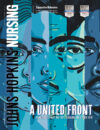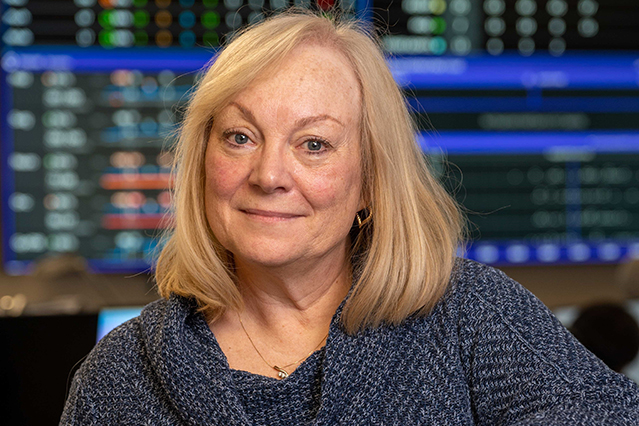By Emily Gaines Buchler
Plenty of holdups can get in the way of discharging patients from the hospital in a timely fashion. One patient might face a medication delivery delay, while another waits for imaging or lab results, and a third needs time with a nurse for extensive discharge instructions.
These and other impediments clog the flow of incoming and outgoing patients at hospitals across the country, including The Johns Hopkins Hospital (JHH).
To improve the stream of beds available, Edna (Pete) Travers (in image above), the interim program director in bed management for JHH’s Capacity Command Center, worked with an interdisciplinary team to launch the Aligned Early Discharge Initiative (previously known as Two by Noon), a program that involves discharging two patients on each hospital unit by noon every day. The initiative started with a staggered rollout in June 2022, beginning with Zayed 11 East, where patients recuperate from orthopedic, spine, trauma-related and general surgery; Zayed 11 West, the recovery unit for urology and thoracic surgery; and Zayed 10 West, the cardiovascular progressive care unit. Eventually, Travers and her team plan to implement the Aligned Early Discharge Initiative across the entire hospital.
Most hospitals have an overarching discharge strategy, but “what makes our plan unique is that nurses lead the charge,” explains Travers. “When a patient is identified as ‘early discharge,’ the nurse nudges individuals in other disciplines to complete their part of the discharge process ahead of time, instead of scrambling at the last minute.”
For Leigh Massey, a nurse on Zayed 11 West, the discharge process involves extensive patient education. “Many of our patients have their prostate removed due to prostate cancer, and discharge involves lengthy education on how to care for a catheter at home and what to expect in the healing process,” Massey explains, so she and her colleagues start training patients the day before they are flagged for discharge.
Key to the initiative’s success, Travers says, is gathering data and identifying bottlenecks in the discharge process. “We track every component, and nurses get real-time data on potential impediments that they can use to troubleshoot,” she explains.
So far, the effort to equip nurses with the data they need to lead and coordinate the discharge process is paying off—on 11 West, for example, an average of 17 percent of patients previously left before noon. That jumped 37 percent in December 2022.
In the Department of Medicine, “We’re seeing patients move more quickly from the emergency room to a private hospital room, where they can get more robust care and ultimately have a better outcome,” Travers says. “We’re also seeing a decompression of intensive care unit beds,” meaning that intensive care unit patients can move to lower levels of care once ready. This, in turn, frees up spots for other critically ill patients.
The Aligned Early Discharge Initiative is also improving satisfaction rates for patients and families. “No patient or family likes spending a longer amount of time in the hospital than is necessary,” says Massey. “Now, more patients can go home during daytime hours, when there’s less traffic on the roads and it’s not dark out.”
Plus, the initiative cuts down on “the huge bolus of admissions and discharges that nurses often juggle in the late afternoon or evening,” Travers adds. In this sense, the program helps make the workload of nurses more manageable.
“It’s like the saying goes: ‘A rising tide lifts all boats,’” Travers says. “When units hit their early discharge targets, everybody benefits, creating a win-win for all involved.”

